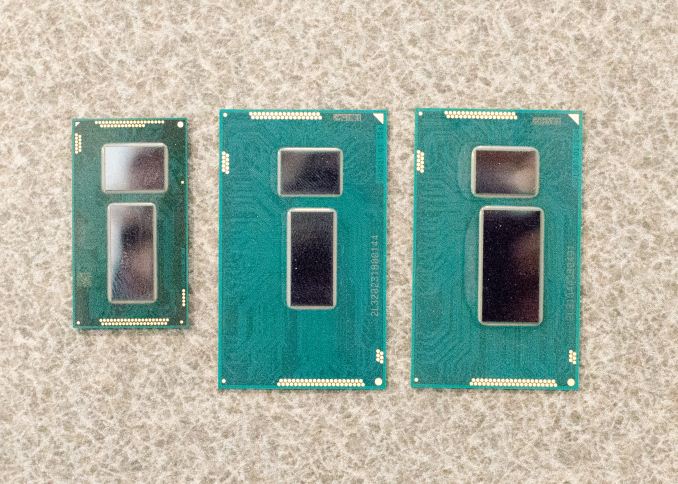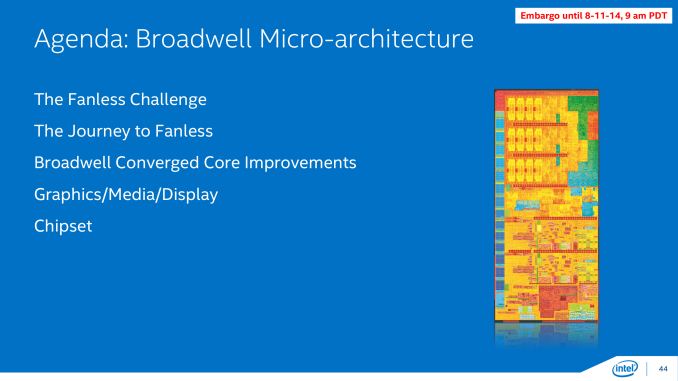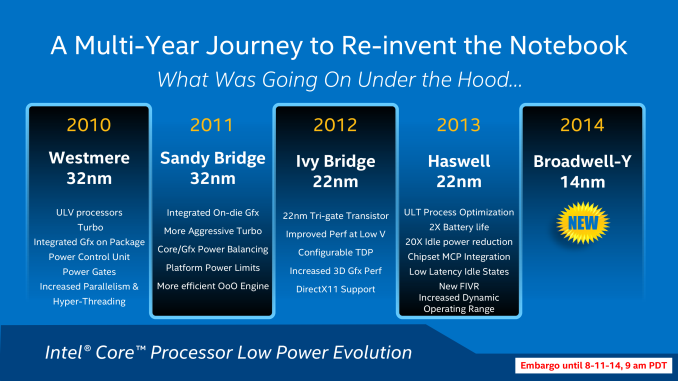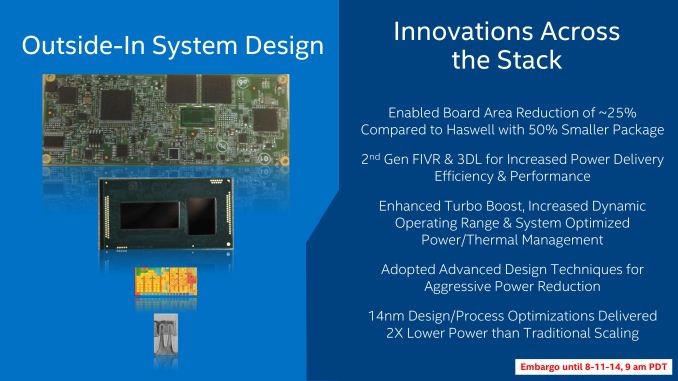Intel Broadwell Architecture Preview: A Glimpse into Core M
by Ryan Smith on August 11, 2014 12:01 PM EST
With Haswell Refresh fully behind us and 2014 now in to its second half, Intel is turning their attention to their next generation of products and processes. Intel’s tick-tock methodology coupled with the long development periods of new products means that the company has several projects in flight at any given time. So while we have seen the name Broadwell on Intel’s roadmaps for some time now, the reality of the situation is that we know relatively little about Intel’s next generation architecture and the 14nm process that it is the launch vehicle for.
Typically we would see Intel unveil the bulk of the technical details of their forthcoming products at their annual Intel Developer Forum, and with the next IDF scheduled for the week of September 9th we’ll see just that. However today Intel will be breaking from their established standards a bit by not waiting until IDF to deliver everything at once. In a presentation coinciding with today’s embargo, dubbed Advancing Moore’s Law in 2014, Intel will be offering a preview of sorts for Broadwell while detailing their 14nm process.
Today’s preview and Intel’s associated presentation are going to be based around the forthcoming Intel Core M microprocessor, using the Broadwell configuration otherwise known at Broadwell-Y. The reason for this is a culmination of several factors, and in all honesty it’s probably driven as much by investor relations as it is consumer/enthusiast relations, as Intel would like to convince consumer and investor alike that they are on the right path to take control of the mobile/tablet market through superior products, superior technology, and superior manufacturing. Hence today’s preview will be focused on the part and the market Intel feels is the most competitive and most at risk for the next cycle: the mobile market that Core M will be competing in.
To that end Intel’s preview is very much a preview; we will see bits and pieces of Broadwell’s CPU architecture, GPU architecture, and packaging, along with information about Intel’s 14nm process. However this isn’t a full architecture preview or a full process breakdown. Both of those will have to wait for Intel’s usual forum of IDF.
Diving into matters then, Core M will be launch vehicle for Broadwell and will be released for the holiday period this year. In fact Intel is already in volume production of the Broadwell-Y CPU and production units are shipping to Intel’s customers (the OEMs) to begin production and stockpiling of finished devices for the holiday launch.
Intel’s decision to initially focus Broadwell on the mobile market comes as the company takes the next step in their plan to extend into the Core processor series into these devices. Arguably, Intel has been slow to response to the rise of ARM devices, whose rapid rise has undercut traditional PC sales and quickly become the biggest threat to Intel’s processor dominance in some number of years. Intel is far from doomed right now, but even they see the potential farther down the line if they do not act.
Intel for their part has responded, but it has taken a step-by-step (multi-year) process that has seen the company progressively build smaller and less power hungry CPUs in order to fit the needs of the mobile market. Since Intel integrated their graphics on-die with Sandy Bridge in 2011, the company has continued to tweak the designs of their products, with Ivy Bridge and Haswell generation products introducing further optimizations and new manufacturing processes. Now on their latest iteration with Broadwell, the company believes they’re turning a corner and have the technology they need to be a leader in the high performance mobile market. It's important to note that despite Intel's best intentions here, Broadwell and Core M remain targeted at premium devices. You won't see these parts in cheap tablets. The duty of doing battle with ARM remains Atom's alone.
Many of these changes ultimately amount to boosting performance and reducing power consumption to a point where power and heat are where they need to be for mobile form factors, either through process efficiency improvements or through better power management and wider dynamic ranges – boosting where it matters and doing a better job of idling between tasks. However as Intel has discovered they not only need to be able to meet the TDP requirements of a tablet but they need to be able to meet the size requirements too. A particularly daunting task when the entire thickness of a device needs to be under 10mm, and the CPU thinner yet.
As a result, coupled with Core M’s performance improvements and power reductions is a strong emphasis on the size of the processor package itself and what Intel could do to reduce it. Intel calls this an outside-in system design, with various parts of Intel focusing on everything from the size of the logic board needed to hold the processor to the thickness of the processor die itself. In the following pages we’ll take a look at Intel’s efforts to get slim, but to kick things off we have a picture of Broadwell-Y from Computex 2014.

From left to right: Broadwell-Y (Core M), Broadwell ULT/ULX and Haswell ULT/ULX
Intel wants a greater foothold in the mobile market and they want it badly. And with Broadwell-Y they believe they finally have what they need to accomplish that goal.














158 Comments
View All Comments
Morawka - Monday, August 11, 2014 - link
wasn't gartner the one who said apple mac sales were down 40% and it turned out to be up 60%mkozakewich - Thursday, August 14, 2014 - link
Those weren't actual numbers, they were industry guesses. The lesson is not to trust pundits and "Industry analysts". If you can wait for proper news to be released, it's better than rumours.lilmoe - Monday, August 11, 2014 - link
Actually, the tablet market as a cause for dropping PC sales is only half or less than half of the story. Logically speaking, most consumers find their 2-4 year old machines sufficient for their "productive" needs. Unlike previous years, PCs are living far beyond their intended years of services, and consumers are in no dire need for newer, faster components. Mind you, hardware isn't getting that much faster with each iteration (relatively speaking), and a simple SSD upgrade and/or more RAM would improve performance significantly that a whole hardware upgrade becomes less appealing (same for other components). It's mostly about convenience, connectivity and mobility for consumers these days (cheap mobile media consumption) that's why the tablet market "appear" to have affected PC sales. Those who find a tablet replacing their fully fledged PC didn't need a PC in the first place.mayankleoboy1 - Monday, August 11, 2014 - link
i remember being very excited to read the Haswell architecture preview.Felt completely disappointed when the actual CPU were reviewed.
Hope BDW-Y is not the same
edlee - Monday, August 11, 2014 - link
they should make a chromebook with this processor.Krysto - Monday, August 11, 2014 - link
My guess is this chip won't be that much faster than Nvidia's Denver - unless Intel cheats in benchmarks somehow (like with TurboBoost).68k - Monday, August 11, 2014 - link
How on earth is TurboBoost cheating? Is it cheating to include a feature that actually does result in a CPU that allow itself to do short sprints in moments where it is needed the most in order to make a device "feel" fast (i.e. respond quickly to events generated by the user)?Cannot talk for BDW but both HSW and SMT usually stay at or very close to max turbo for _very_ long, Z3770 sitting inside a 10" tablet can run at 2.3-2.4GHz on all 4 cores for several minutes.
nonoverclock - Monday, August 11, 2014 - link
AMD has a turbo mode. Do they cheat?psyq321 - Tuesday, August 12, 2014 - link
TurboBoost is not cheating but optimal demand-based power management.All modern ARM CPUs are also doing the same thing (scaling down frequency when idle, up when busy). I am quite sure it is the case with the AMD CPUs, too - it is just that I do not have any to check.
The only three things that matter are a) price b) performance c) power draw (real that is measured, not marketing terms such as TDP, SDP, etc.).
mkozakewich - Thursday, August 14, 2014 - link
TDP isn't a marketing term, it's the wattage of heat displayed by the processor. Wattage is a bit of a weird word for it, but Watts are joules-per-second, and a joule is the amount of energy needed to heat water a certain amount.